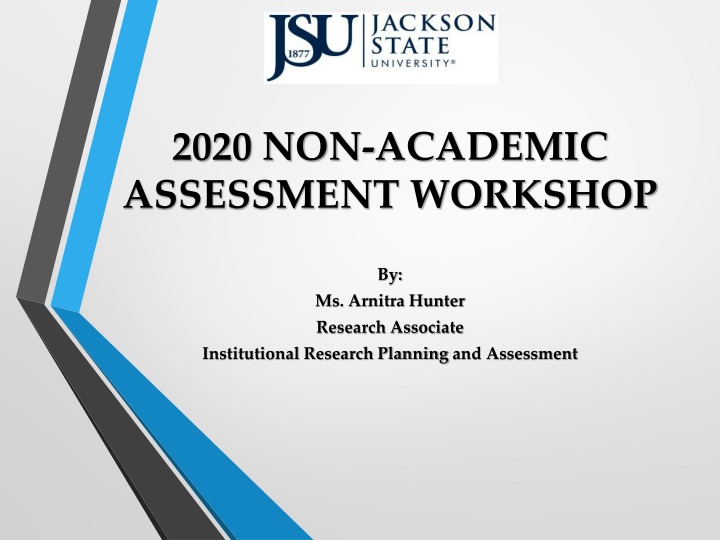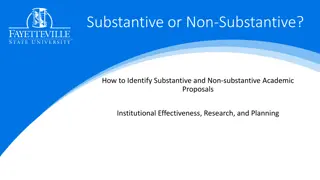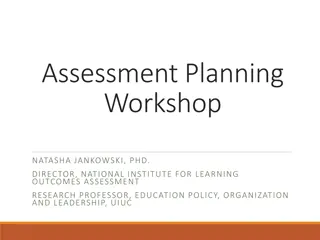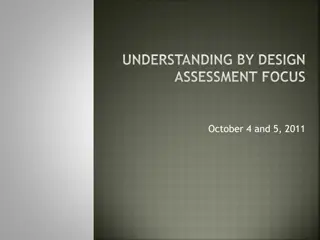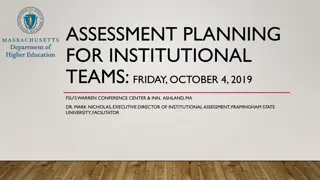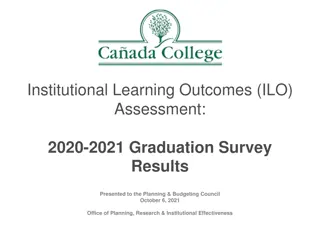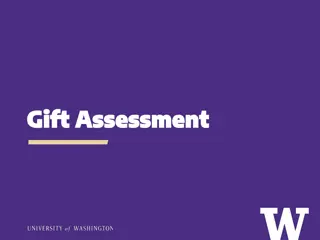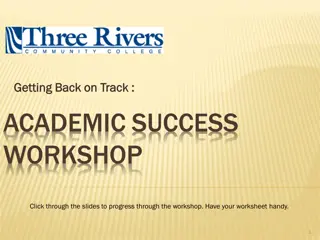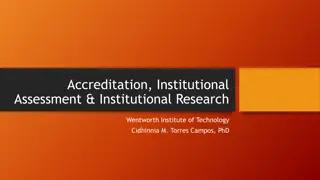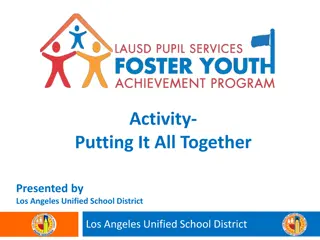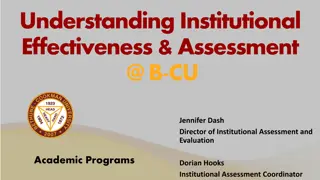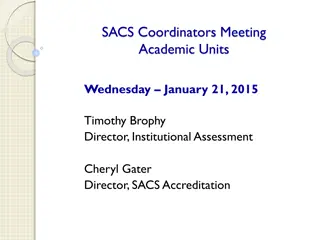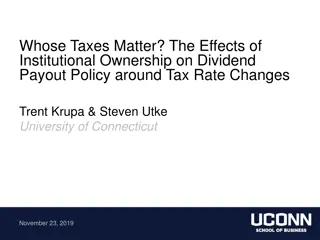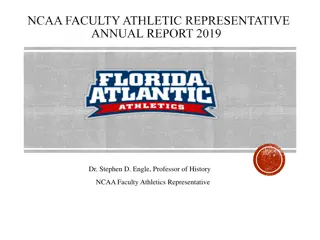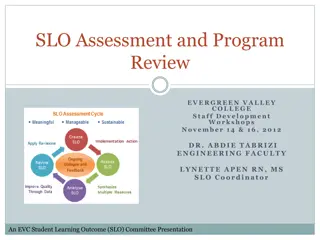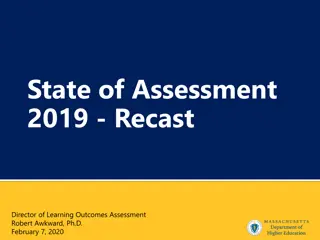Workshop on Non-Academic Assessment for Institutional Improvement
Delve into the intricacies of assessment reporting, submission procedures, and templates while aligning with SACSCOC expectations. Explore Jackson State University's mission, vision, pillars of success, and presidential goals centered around student success, academic prominence, athletic excellence, campus aesthetics, and community engagement.
Download Presentation

Please find below an Image/Link to download the presentation.
The content on the website is provided AS IS for your information and personal use only. It may not be sold, licensed, or shared on other websites without obtaining consent from the author.If you encounter any issues during the download, it is possible that the publisher has removed the file from their server.
You are allowed to download the files provided on this website for personal or commercial use, subject to the condition that they are used lawfully. All files are the property of their respective owners.
The content on the website is provided AS IS for your information and personal use only. It may not be sold, licensed, or shared on other websites without obtaining consent from the author.
E N D
Presentation Transcript
2020 NON-ACADEMIC ASSESSMENT WORKSHOP By: Ms. Arnitra Hunter Research Associate Institutional Research Planning and Assessment
Session Goals To understand Assessment Reporting To understand the how to when submitting the completed assessment report. To re-visit assessment templates to ensure understanding and completion of all necessary components. To visit SACSCOC expectations and standard documentation criteria (2018 SACSCOC Principles of Accreditation Manual)
Agenda Assessment Planning/Reporting Cycle Assessment Template Work Session Question and Answer Session
JSU MISSION AND VISION MISSION: The University produces technologically-advanced, diverse, ethical, global leaders who think critically, address societal problems, and compete effectively. VISION: Building on its historic mission of empowering diverse students to become leaders, Jackson State University will become recognized as a challenging, yet nurturing, state-of- the-art technologically-infused intellectual community. Students and faculty will engage in creative research, participate in interdisciplinary and multi-institutional/ organizational collaborative learning teams and serve the global community.
THREE PILLARS OF UNIVERSITY SUCCESS STUDENT CENTEREDNESS TEAMWORK & COLLEGIALITY THE PURSUIT OF EXCELLENCE/RAISING THE BAR
PRESIDENTIAL GOALS STUDENTS FIRST & FOREMOST- Become one of the most student-centered universities in the country by implementing relevant and appropriate Student Success strategies, developing students holistically and ensuring student Return on Investment ACADEMIC & RESEARCH PROMINENCE Become one of the most respected and prominent research universities in the country by maintaining our higher research status, becoming a Top U.S. News & World Report ranked HBCU, having the best and most extensive HBCU Online degree program offerings and fulfilling our designation as Mississippi s Public Urban Research University ATHELETIC PROWESS RETURN OF THE GLORY DAYS OF JSU SPORTS Become one of the premier NCAA FCS sports programs in the country, where student-athletes compete fearlessly on and off the field, are retained and graduate, have access to quality coaching, mentorship and facilities and are actively engaged in campus life beyond athletics. CAMPUS AESTHETICS & SUSTAINABILITY - Retain and grow our status as one of the most beautiful and attractive urban campuses in the country by continuously investing in our physical plant and grounds, repairing and renovating older facilities and building new structures in order to compete favorably for students, faculty and staff. CHANGING THE CULTURE, DEFINING TIGER PRIDE & EMBRACING OUR STATUS AS A COMMUNITY PILLAR Become nationally known for quality customer service; efficient and effective operations; nurturing; caring and competent, faculty and staff; alumni who readily give of their time, talent and treasure, and fulfilling our call to be a great community, city and state resource and partner
ASSESSMENT GOAL Goal To maintain a culture of assessment at Jackson State University in both academic and non-academic areas whereby improvements in organizational efficiency is observed for administration, faculty, staff, students, and other stakeholders.
WHY IS ASSESSMENT IMPORTANT? STUDENT LEARNING Goal Attainment Decision Making Accountability University Accreditation SACSCOC 7.1; Institutional Effectiveness 8.1; Student Achievement and 8.2.a (Student Outcomes: Educational Programs) (2018 SACSCOC Principles of Accreditation Manual) Improvement in Service to Students
YOUR ROLE University INVOLVE YOUR DEPARTMENT SUCCESS ASSESSMENT YOU ARE THE VIP OF YOUR DEPARTMENT STUDENT LEARNING
Assessment Planning/Reporting Demographics Fiscal Year Division Departmental Name Department Mission
Assessment Planning/Reporting Goals/ Objectives Use of Results Means of Assessment Assessment Results Criteria for Success
Summary of Assessment Major Difficulties Summary Conclusions New Year Goals and Objectives Date Approved By Completed
DEFINING GOALS AND OBJECTIVES Goals Broad statements of meaningful expectations, achievable, assessable, and consistent with mission. Objectives Brief, clear statements of outcomes, measurable, realistic, achievable, consistent with the goals. Worded in terms of what the unit will accomplish or what its clients would think, know, or do following the provision of services.
Are these Goals? To Increase students, faculty and staff participation in community development and engagement projects Provide and maintain a variety of resources adequate to meet the learning, teaching and research needs of library constituents Track group classes by attendance, gender, and age
MEANS OF ASSESSMENT Assessment Measures How will the success of the outcome be measured? Multiple Measures 2 per objective Use methods that evaluate more than one objective. Direct Measures (sign-in sheets, reports, projects, data program, etc) Indirect Measures (surveys, focus groups, interviews, etc.)
Are these Means of Assessments? Checklist and sign-in sheet will be designed to ensure that all activity directors have met with the Title III Administration Team. Maintain steady research funding dollars at approx. $30 million-$40 annually We completed this goal on schedule. Include test cases for various browsers in future test plans.
CRITERIA FOR SUCCESS Success Criteria Standards of Success Define your goals and targets to reach for each goal. Baseline data Include dates for which objectives will be reached Written in anticipation of desired results
Are these Criteria for Success? In 2018, 620 students that participated in tournaments. We expect a 2% increase of student s participation in tournaments. Develop, compile, and maintain an updated listserv for currently enrolled students that are registered. Get at least 50 students, 5 faculty and staff to sign up for community service projects.
ASSESSMENT RESULTS Describe the process used to analyze and summarize results. Document your results! Does the data fail to meet, meets, or exceeds the criterion for success?
Are these Assessment Results? There were 238 students who utilized Type Focus this academic year, this number is up form 218 last year. Results on this objective is ongoing. Community events declined rom 144 in FY 18 to 59 in FY 19 resulting in a %59 decrease.
USE OF RESULTS TO IMPROVE SERVICES Data Results should indicate steps to improve or revise assessment processes. Results > Criteria for Success Revise the assessment process to increase success criteria or assessing another outcome/aspect of outcome may be necessary. Results < Criteria for Success Specific improvements are necessary.
MAJOR DIFFICULTIES Major Difficulties: Road Blocks Different components that may have kept your area from accomplishing your goal.
SUMMARY CONCLUSIONS This section should conclude how the Three Pillars of University Success as it relate to your department. Student centeredness Teamwork and Collegiality The Pursuit of Excellence/Raising the Bar
NEXT YEARS OPERATIONAL GOALS & OBJECTIVES
Submission and Review Assessment Plans FY 2020 November 1, 2019 (Upload- via website) Assessment Plan Feedback, January 2020 Assessment Reports FY 2020 July, 2020 (Upload-via website) Assessment Report Feedback, August, 2020
